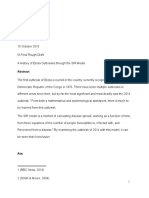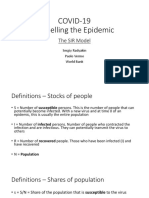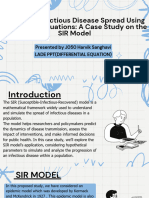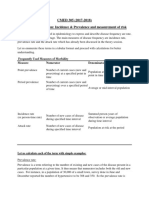S - I - R Model: Modeling Calculus Brian and Mariah Birgen
S - I - R Model: Modeling Calculus Brian and Mariah Birgen
Uploaded by
mardika pranataCopyright:
Available Formats
S - I - R Model: Modeling Calculus Brian and Mariah Birgen
S - I - R Model: Modeling Calculus Brian and Mariah Birgen
Uploaded by
mardika pranataOriginal Description:
Original Title
Copyright
Available Formats
Share this document
Did you find this document useful?
Is this content inappropriate?
Copyright:
Available Formats
S - I - R Model: Modeling Calculus Brian and Mariah Birgen
S - I - R Model: Modeling Calculus Brian and Mariah Birgen
Uploaded by
mardika pranataCopyright:
Available Formats
3.
S - I - R Model
A model for disease transmission requires dividing the population into three distinct groups: the suscep-
tibles, the infected and the recovered. Individuals who have not yet gotten sick are part of the susceptible
group, S(t). Individuals with the disease are part of the infected group, I(t). Individuals who have recovered
from the disease and are assumed to non longer be susceptible (either due to immunity or death) are part
of the recovered group, R(t).
Model 6.2. The model for disease transmission is based on the number of interactions between infected
individuals and susceptible individuals. As individuals get sick, they move from the susceptible group to the
infected group. At the same time, individuals in the infected group recovered from the disease at a rate
proportional to the number of individuals who are infected. (See Figure 3)
Figure 5. Basic S - I - R Model
We can write this as a system of differential equations
dS
= −rSI r >0
dt
dI
= rSI − aI a >0
dt
dR
= aI
dt
Observe that dS/dt + dI/dt + dR/dt = 0 so that the population remains constant. The term r is the
transmission constant and it represents how virulent the disease is. The term a is the recovery constant.
This can be shown to be a = 1/d where d is the average number of days it takes to recover from the disease.
Consider the example of flu transmission at a small liberal arts college. Assume that S(0) = 1800, that
is the entire population is susceptible, and I(0) = 1, that is a single infected student comes to campus.
Assume 10 days recovery time for the flu and let r = .0008.
Observe in Figure 3 that the number of susceptibles starts high and drops as individuals get sick. In
response the number of infected individuals rise. Over time the sick individuals recover, so that the number
of infected goes down and the number of recovered rises. Eventually, the disease runs its course and everyone
has gotten sick and recovered, so that the number of recovered approaches the size of the entire population.
105
Modeling Calculus Brian and Mariah Birgen
Figure 6. Graphs for flu transmission through population
106
Modeling Calculus Brian and Mariah Birgen
Homework.
1. Consider a population of size 5000, in which a single infected individual is introduced. Assume
the disease lasts one week on average and the transmission constant is .00007. How long does
it take until 95% of the population is recovered? When are the most people sick? When are
people getting sick the fastest?
2. Consider a strain of the flu with average recovery time of 10 days and a transmission rate of
.0008 in introduced into a population of size 2000. Re-create the S-I-R model for this disease.
Suppose received a flu vaccine was an option. Create a new group called the vaccinated
(denoted V (t)), where on the first day of the model up to 50 individuals can be removed from
the susceptible pool and placed in the vaccinated pool. Additionally assume that the immunity
from the vaccine is not permanent, and lasts on average 100 days. This gives the equation
dV
= max{S, 50} − .01V
dt
with appropriate changes made in the equation for dS/dt. Determine how many people get sick
in this model?
3. Consider a strain of the flu with average recovery time of 10 days and a transmission rate of
.0007 in introduced into a population of size 6000. Re-create the S-I-R model for this disease.
Suppose there is an attempt to quarantine infected individuals. That is, infected individuals
are moved into a separate pool (denoted Q(t)) so that they do not interact with susceptible in-
dividuals. Assume that quarantined individuals recover at the same rate as infected individuals
left in the general population.
Create a model with a 50% quarantine rate. How does the course of the disease change?
Repeat the model with a 75% quarantine rate. How does the course of the disease change?
How high does the quarantine rate need to get before there is significant change in the behavior
of the disease moving through the population?
107
Modeling Calculus Brian and Mariah Birgen
4. Malaria
Malaria is another infectious disease with a different transmission model.
Model 6.3. Humans with malaria do not directly infect other humans. Human catch malaria if they
are bitten by an infected mosquito, called a vector in Biology. Similarly, mosquitoes with malaria do not give
malaria to other mosquitoes, rather mosquitoes catch malaria by biting an infected human.
This gives a kind of S − I − R model with two interacting species. At first glance the model looks like
Figure 4.
Figure 7. Initial Malaria Model
However, the lifespan of a mosquito is so short that they do not recover from malaria. For this model to
be useful it needs to account for the multiple generations of mosquitoes. In nature the female mosquito lives
for an average of one to two weeks. As new mosquitoes are born, they are malaria free, so they are added
to the susceptible mosquito population. If we denote the susceptible mosquitoes as SM , infected mosquitoes
as IM , susceptible humans as SH , infected humans as IH and recovered humans as RH , we get the following
set of differential equations.
dSH dIH
= −rH SH IM = rH SH IM − dH IH − aIH
dt dt
dRH
= aIH
dt
dSM dIM
= b(SM + IM ) − dM SM − rM SM IH = rM SM IH − dM IM
dt dt
Here dH is the death rate for humans and dM is the death rate for mosquitoes. The term rH is the likelihood
of a bite occurring between an infected mosquito and a susceptible human and the disease being transmitted.
The term rM is the similar term for mosquitoes. The birth rate for mosquitoes is b, which is multiplied by the
total number of mosquitoes. Finally, a is the recovery rate for malaria, which is quite small. The modified
diagram is given in Figure 4.
We can set some initial values. Let SH (0) = 1000, IH (0) = 1, RH (0) = 0, SM (0) = 1000, IM (0) = 0.
Additionally set dM = .1, dH = .002, rH = .002, rM = .002, b = .1 and a = .005. This results in the
following graphs:
Figure 4 is for the first 100 days, while Figure 4 is for the first 1000 days. Observe that in the first few
days of the outbreak, the number of susceptible humans drops to near zero, while the number of infected
human rises quickly. Similarly, the number of infected mosquitoes also rises quickly and the number of
susceptible mosquitoes drops, but the number of susceptible mosquitoes does not approach zero, because
108
Modeling Calculus Brian and Mariah Birgen
Figure 8. Improved Malaria Model
Figure 9. Malaria Model for 100 days
new susceptible mosquitoes are constantly being born. The number of recovered immune humans starts
to grow slowly. In the long run of the disease, the number of susceptible humans stays near zero, and the
infected humans become recovered and immune. Once the number of infected humans drops low enough, the
number of infected mosquitoes also drops until the epidemic runs its course and there are no more infected
humans or mosquitoes. Also observe that the final population of recovered humans is significantly lower that
the starting population.
109
Modeling Calculus Brian and Mariah Birgen
Figure 10. Malaria Model for 1000 days
110
Modeling Calculus Brian and Mariah Birgen
Homework 6.4.
1. Reproduce the malaria model where SH (0) = 1000, IH (0) = 1, RH (0) = 0, SM (0) = 100,
IM (0) = 0, dM = .1, dH = .002, rH = .002, rM = .002, b = .1 and a = .005. What is the final
population of humans left after the epidemic has run its course? How is this different from the
model in the text? What happens if SM (0) = 10?
2. How does this model change if mosquito nettings are widely used to decease the incidence of
mosquito bites? Reproduce the modified model and describe the long term behavior.
3. How does this model change if insecticides in still water are widely used to decease the birth
rate of mosquitoes? Reproduce the modified model and describe the long term behavior.
4. How does this model change if genetically modified male mosquitoes are released? The mosquitoes
are modified in such a way that any female eggs do not survive to adulthood. Reproduce the
modified model and describe the long term behavior.
5. How does this model change if genetically modified male mosquitoes are released? The mosquitoes
are modified in such a way that any female eggs do not survive to adulthood. However, there
are sill male and female mosquitoes drifting in from neighboring areas. Reproduce the modified
model and describe the long term behavior.
111
Modeling Calculus Brian and Mariah Birgen
You might also like
- BASIC SCIENCE PRACTICE QUESTIONS (Grade 7)Document10 pagesBASIC SCIENCE PRACTICE QUESTIONS (Grade 7)Richard83% (6)
- Mathematical Modeling of Diseases: Susceptible-Infected-Recovered (SIR) ModelDocument13 pagesMathematical Modeling of Diseases: Susceptible-Infected-Recovered (SIR) ModelAzaria Evangelia NatashaNo ratings yet
- Influenza Stella ModelDocument6 pagesInfluenza Stella ModelPatrick Woessner100% (2)
- Maths Coursework JDocument5 pagesMaths Coursework JAnimaNo ratings yet
- The Mathematics Behind ContagionDocument6 pagesThe Mathematics Behind Contagionkoonertex50% (2)
- MSBME Lab Task Lab8Document4 pagesMSBME Lab Task Lab8laibakhaliq492No ratings yet
- Susceptible, Infected, Recovered: The SIR Model of An EpidemicDocument16 pagesSusceptible, Infected, Recovered: The SIR Model of An Epidemicmirast91No ratings yet
- HL Math IA v2Document18 pagesHL Math IA v2jazzycat08No ratings yet
- Mathematical Modelling of Infectious DiseasesDocument11 pagesMathematical Modelling of Infectious DiseasesBOBBY212No ratings yet
- 1 s2.0 S0022039614002228 MainDocument27 pages1 s2.0 S0022039614002228 Mainsonimohit895No ratings yet
- Notes On R: 1 The Basic Reproduction Number in A NutshellDocument19 pagesNotes On R: 1 The Basic Reproduction Number in A Nutshelltotto pastimeNo ratings yet
- Oscillations in SIRS Model With Distributed DelaysDocument12 pagesOscillations in SIRS Model With Distributed DelaysMarcelo F. C. GomesNo ratings yet
- 1127-1131 Rrijm180310228Document5 pages1127-1131 Rrijm180310228Sunil NegiNo ratings yet
- Network Models in Epidemiology: Considering Discrete and Continuous DynamicsDocument11 pagesNetwork Models in Epidemiology: Considering Discrete and Continuous Dynamicstigetit596No ratings yet
- COVID-19 Modelling The EpidemicDocument13 pagesCOVID-19 Modelling The EpidemicSubhangi NandiNo ratings yet
- Howard (Howie) Weiss: Sir Ronald RossDocument17 pagesHoward (Howie) Weiss: Sir Ronald RossFdWork0% (1)
- Epidemics Lectures PANDADocument31 pagesEpidemics Lectures PANDAsathis_iptb3980No ratings yet
- Mathematical Model For Malaria TransmissionDocument32 pagesMathematical Model For Malaria TransmissionAunisaliNo ratings yet
- Seasonal Influenza: Matlab Simulation ExperimentDocument15 pagesSeasonal Influenza: Matlab Simulation ExperimentAnonymous ti6SdCNo ratings yet
- Calculus in EpidemiologyDocument15 pagesCalculus in Epidemiologysabya.rathoreNo ratings yet
- Research Article: Qualitative Analysis of Delayed SIR Epidemic Model With A Saturated Incidence RateDocument14 pagesResearch Article: Qualitative Analysis of Delayed SIR Epidemic Model With A Saturated Incidence RateBrittoNo ratings yet
- Epidemic ModelDocument24 pagesEpidemic ModelMd Riaj UddinNo ratings yet
- Yellow Fever G06-EDocument6 pagesYellow Fever G06-EbleejunanNo ratings yet
- SIR Model of EpidemicsDocument9 pagesSIR Model of EpidemicsMhamed HammoudiNo ratings yet
- Application of Differential EquationsDocument19 pagesApplication of Differential EquationsMuhammad AmanNo ratings yet
- Deterministic Malaria Transmission Model With Acquired ImmunityDocument6 pagesDeterministic Malaria Transmission Model With Acquired ImmunityAchmad Nur AlphiantoNo ratings yet
- Unesco - Eolss Sample Chapters: Mathematical Models in EpidemiologyDocument6 pagesUnesco - Eolss Sample Chapters: Mathematical Models in EpidemiologySuhendi Az-zainyNo ratings yet
- LiDocument18 pagesLiBibi Yusra RuhomallyNo ratings yet
- Mathematical Models of EpidemicsDocument15 pagesMathematical Models of Epidemics2021 03031No ratings yet
- EpidemiologyDocument27 pagesEpidemiologyRiad HossainNo ratings yet
- 10 59292-Bulletinbiomath 2024001Document20 pages10 59292-Bulletinbiomath 2024001prnjanNo ratings yet
- Greer 2018Document5 pagesGreer 2018Jorge VegaNo ratings yet
- Long-Term Behavior of Stochastic Siqrs Epidemic ModelsDocument22 pagesLong-Term Behavior of Stochastic Siqrs Epidemic Modelspradeep kumarNo ratings yet
- Modeling and Policy Analysis For An Epidemic: BackgroundDocument4 pagesModeling and Policy Analysis For An Epidemic: BackgroundFidaa JaafrahNo ratings yet
- Mathematical Model For Malaria Transmission Dynamics in Human and Mosquito Populations With Nonlinear Forces of InfectionDocument32 pagesMathematical Model For Malaria Transmission Dynamics in Human and Mosquito Populations With Nonlinear Forces of InfectionAshimi Blessing AyindeNo ratings yet
- Agusto 2012 PDFDocument22 pagesAgusto 2012 PDFAsih Do LaluNo ratings yet
- Introduction To Compartmental Modeling For The Buddinginfectious Disease ModelerDocument27 pagesIntroduction To Compartmental Modeling For The Buddinginfectious Disease ModelermarkNo ratings yet
- SirDocument9 pagesSir思恩0% (1)
- Unit 10Document20 pagesUnit 10S. KumarNo ratings yet
- Lecture Note 2Document38 pagesLecture Note 2hong huiNo ratings yet
- Infectious Diseaes and ModelingDocument46 pagesInfectious Diseaes and ModelingIntan GeaNo ratings yet
- Project PresentationDocument13 pagesProject Presentationharvik07opNo ratings yet
- Models of DiseaDocument10 pagesModels of DiseaNuru JemalNo ratings yet
- MD 07Document109 pagesMD 07Lakshmi SethNo ratings yet
- MD 03Document82 pagesMD 03Lakshmi SethNo ratings yet
- Jurnal 1Document10 pagesJurnal 1NurulMagfirahRaufNo ratings yet
- (Cory M. Simon) SIR-dynamic-modelDocument17 pages(Cory M. Simon) SIR-dynamic-modelShabbir ChaudharyNo ratings yet
- SIR Models: An Introduction: Tingda Wang July 2020Document19 pagesSIR Models: An Introduction: Tingda Wang July 2020Zan DaoNo ratings yet
- Transmission Model For Dengue Disease With and Without The Effect of Extrinsic Incubation PeriodDocument9 pagesTransmission Model For Dengue Disease With and Without The Effect of Extrinsic Incubation PeriodDilruk GallageNo ratings yet
- Ndairou Et Al 2017 Mathematical Modeling of Zika DiseaseDocument13 pagesNdairou Et Al 2017 Mathematical Modeling of Zika DiseaseCarlos AndradeNo ratings yet
- 72 - The Reed Frost Model and Its Applications To Real LifeDocument11 pages72 - The Reed Frost Model and Its Applications To Real LifeLamine Mane ManéNo ratings yet
- (Prak Pemmat) An - Age-Dependent - Epidemic - Model - With - AppDocument18 pages(Prak Pemmat) An - Age-Dependent - Epidemic - Model - With - AppAznadillah SyahlaNo ratings yet
- Maths Exploration - MethushaaDocument18 pagesMaths Exploration - MethushaaAnay ThulghariaNo ratings yet
- ∂S (t,x) ∂ t B (t, x) −dS (t, x) −β (t, x) S (t, x) I (t, x) +D S t, x)Document2 pages∂S (t,x) ∂ t B (t, x) −dS (t, x) −β (t, x) S (t, x) I (t, x) +D S t, x)Wei ChitNo ratings yet
- Maths of Disease Matt Keating CambridgeDocument8 pagesMaths of Disease Matt Keating Cambridgesinxcosx75No ratings yet
- MalariaDocument21 pagesMalariagurumatNo ratings yet
- Measuring Risk, Incidence - Prevalence (Practical)Document6 pagesMeasuring Risk, Incidence - Prevalence (Practical)kyomuhendobright4No ratings yet
- Measuring Diseases (Lecture Materials, Agst 2023)Document28 pagesMeasuring Diseases (Lecture Materials, Agst 2023)JaslynNo ratings yet
- Math EE IBDocument22 pagesMath EE IBCalc girl ReddingtonNo ratings yet
- Epidemiology Modeling With StellaDocument33 pagesEpidemiology Modeling With Stellaqiuyan.yuanNo ratings yet
- Beat the Flu: Protect Yourself and Your Family From Swine Flu, Bird Flu, Pandemic Flu and Seasonal FluFrom EverandBeat the Flu: Protect Yourself and Your Family From Swine Flu, Bird Flu, Pandemic Flu and Seasonal FluNo ratings yet
- Chapter 1-3 FinalDocument31 pagesChapter 1-3 FinalJudy Ann SolimanNo ratings yet
- Mosquito Control: Department of Zoology University of PeradeniyaDocument4 pagesMosquito Control: Department of Zoology University of PeradeniyaniroshniroshNo ratings yet
- Sample 7E Lesson PlanDocument3 pagesSample 7E Lesson PlanJan BajeNo ratings yet
- Complete Exercise 1 Direction: in 40 Minutes, Answer The Questions Following The Reading Passages BelowDocument12 pagesComplete Exercise 1 Direction: in 40 Minutes, Answer The Questions Following The Reading Passages BelowRizki WolesNo ratings yet
- RRL RrsDocument5 pagesRRL RrsYeh HeetNo ratings yet
- Hakbang Barangay Laban Dengue: I. Basic InformationDocument3 pagesHakbang Barangay Laban Dengue: I. Basic InformationErullyn KimNo ratings yet
- KESK p5 Science MIDTERM II 2023Document12 pagesKESK p5 Science MIDTERM II 2023sebuddenoah1No ratings yet
- Prevalence of Dengue Viral Infections Among Febrile Patients in Mombasa County, KenyaDocument95 pagesPrevalence of Dengue Viral Infections Among Febrile Patients in Mombasa County, KenyaMuhammad AyazNo ratings yet
- Science Q2 WK5 Day 1-5Document57 pagesScience Q2 WK5 Day 1-5Reniel SabacoNo ratings yet
- Level 6 Passage 1 PDFDocument3 pagesLevel 6 Passage 1 PDFPerpustakaan Smandel100% (1)
- Makalah Plendis Kelompok 4Document25 pagesMakalah Plendis Kelompok 4Khairunnisa AssalmaNo ratings yet
- Buzzkill: Sistema Auditivo de Los MosquitosDocument7 pagesBuzzkill: Sistema Auditivo de Los MosquitosAlexis Adrián Guerrero ZarcoNo ratings yet
- Microorganisms: Friends and FoeDocument32 pagesMicroorganisms: Friends and FoePROYASH ASSAM100% (1)
- 3M Dalam Bahasa InggrisDocument4 pages3M Dalam Bahasa InggrisRahmalia amandaNo ratings yet
- Fisika NuklirDocument10 pagesFisika NuklirFarkhan AriefNo ratings yet
- Ae. Linneatopennis HabitatDocument13 pagesAe. Linneatopennis Habitatnur rahmaNo ratings yet
- Spotters FinalDocument24 pagesSpotters Finalhpcdhp4wkmNo ratings yet
- Hira (Hazard Identification and Risk Assessment)Document44 pagesHira (Hazard Identification and Risk Assessment)Sayali sadhNo ratings yet
- Health6 - Q3 - Module 7 Ways To Prevent and Control Pests and RodentsDocument19 pagesHealth6 - Q3 - Module 7 Ways To Prevent and Control Pests and RodentsALMA MALLONGANo ratings yet
- Ielts - Reading Test2Document8 pagesIelts - Reading Test2Irena Špadina75% (4)
- FILE - 20210320 - 071022 - ASEAN Tiếng Anh 3 - Mã Đề 908Document5 pagesFILE - 20210320 - 071022 - ASEAN Tiếng Anh 3 - Mã Đề 908Son Nguyen TrungNo ratings yet
- Efficacy of Leaves of Lantana Camara As Mosquito RepellentDocument8 pagesEfficacy of Leaves of Lantana Camara As Mosquito RepellentEditor IJTSRDNo ratings yet
- Half Moon Bay Orchids Agrees To Pollution Penalty: Heat Nba ChampsDocument32 pagesHalf Moon Bay Orchids Agrees To Pollution Penalty: Heat Nba ChampsSan Mateo Daily JournalNo ratings yet
- Advances in Insect Physiology Volume 47 Dhadialla, Tarlochan S. - Gill, Sarjeet S-Insect Midgut and Insecticidal Proteins,-Academic Press, Elsevier 2014Document425 pagesAdvances in Insect Physiology Volume 47 Dhadialla, Tarlochan S. - Gill, Sarjeet S-Insect Midgut and Insecticidal Proteins,-Academic Press, Elsevier 2014Paul Palacin GuerraNo ratings yet
- 2014-Maybe Used-Ocotea CymbarumDocument10 pages2014-Maybe Used-Ocotea CymbarumDwiNo ratings yet
- English IIIDocument4 pagesEnglish IIIprecillaugartehalagoNo ratings yet
- Repurposing Isoxazoline Veterinary Drugs For Control of Vector-Borne Human DiseasesDocument7 pagesRepurposing Isoxazoline Veterinary Drugs For Control of Vector-Borne Human DiseasesRudson RomeroNo ratings yet
- FinallDocument7 pagesFinallannis munajiNo ratings yet
- Effectivity of The Ovicidal Larvicidal TrapDocument4 pagesEffectivity of The Ovicidal Larvicidal TrapMichael Angelo Delgado100% (1)

























































































